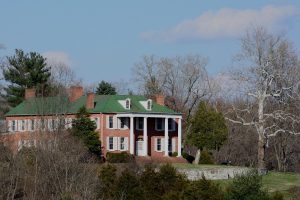Ferry Hill Plantation
The river crossing at Packhorse Ford, located about a mile downstream from Shepherdstown, could not meet the needs of a growing population. Thomas Van Swearingen began operating a ferry in 1765. This location provided easy access to towns on both sides of the river including Charles Town and Harpers Ferry, VA and Hagerstown, Frederick, and Baltimore, MD. In 1775 Van Swearingen had constructed a "Ferry Inn" at the landing on the Maryland side of the river. The community that grew as a result of the ferry became known as Bridgeport.
John Blackford acquired interest in the ferry and adjoining acres through an inheritance from the Van Swearingen family when he married Sara van Swearingen in in 1805. Sadly, she died at the age of 25. He remarried Elizabeth Knode in 1812 and it was then that he built Ferry Hill. Looking for an ideal location to build a home and start his family he decided to build the house high on the bluff overlooking the Potomac River. The land was fertile, and the nearby river, with a convenient ferry crossing, would facilitate delivery of his crops to market. Eventually the farm grew to over 700 acres.
“Seeing a beautiful mansion perched on the summit of a lofty eminence, on the opposite shore, … crossed the river. After a pretty fatiguing walk up a moderate mount, I found myself on a level plain, where sits the mansion, or palace, rather of---. It is built in the form of an L, and is the most splendid building of any country house in the state, and view from it is equally grand.” –Anne Royall, 1828
In 1833 Blackford sold 41 acres, 3 rods, 1 perch (5 1/2 yards) to the Chesapeake and Ohio Canal Company. John Blackford continued to operate the ferry and utilized the canal to transport goods.
As transportation needs grew, the ferry proved inadequate. Franklin Blackford sold the ferry and surrounding property to the Virginia and Maryland Bridge Company, and by 1850 a toll bridge was constructed.
The home's location drew attention to Ferry Hill Place again in 1861. Henry Kyd Douglas lived there with his parents, the Reverend Robert Douglas and his wife Helena. When the Civil War war broke out Henry enlisted in the Army of the Confederacy. The Federal Army looked upon the family with mistrust. The family was held under house arrest for most of the war. They were instructed to keep the shutters closed. One stormy evening a shutter was blown open. The Union Officers saw this as an act of treason, inferring the Reverend was signaling to the Confederates across the river. Reverend Douglas was arrested as a spy. Although he was never formally charged, he was held at Fort McHenry for several months before being allowed to go home.
“For some years before the war I had lived at “Ferry Hill Place,” in Maryland and on a hill over against Shepherdstown, where from the gallery of its old house I could look for miles out into Old Virginia. The Potomac, spanned by a convenient bridge, formed no obstacle to constant, friendly communication and represented no hostility between those on opposite sides; and it never occurred to me what it would represent from 1861 to 1865.” –Henry Kyd Douglas, I Rode with Stonewall
The property passed on to Nannie Cowen, a daughter of John and Helena, who, with her husband, ran a pig farm from 1914 through 1928. Times were hard, but the Beckenbaughs continued to struggle on. In 1941, the family turned Ferry Hill into a restaurant, which it remained until 1974, despite being sold to a restaurant employee.
The link with John Blackford was severed in 1951 when the house was sold to Frederick Morrison. It provided a perfect location for a restaurant. Many students from Shepherd College recall enjoying an evening of dining and dancing at Ferry Hill. It was during this period that extensive changes were made to the house. The imposing columns facing the river were added. The wall separating the kitchen from the dining room and the servant's staircase were removed. An addition was added to the back of the main house and many of the out buildings were torn down.
In 1973, the house was sold to the National Park Service. Because of its location along the Chesapeake and Ohio Canal, it served as the headquarters of the Chesapeake and Ohio Canal National Historical Park from 1979 until 2001.
Text courtesy National Park Service
Add to Itinerary
You can now create your own itineraries to guide your C&O Canal exploration, or you can copy one of ours! Lean more about Itineraries.

Ferry Hill Plantation By: Paula Tremba
Photo by: Paula Tremba
Nearby Amenities:
 Ferry Hill Restrooms
Ferry Hill Restrooms
Approximately 0 miles away. Ferry Hill Parking
Ferry Hill Parking
Approximately 0 miles away. Lock 38 (Shepherdstown) Restrooms
Lock 38 (Shepherdstown) Restrooms
Approximately 0.1 miles away. Lock 38 (Shepherdstown) Parking
Lock 38 (Shepherdstown) Parking
Approximately 0.1 miles away. Railroad Bridge Parking (Canal Road)
Railroad Bridge Parking (Canal Road)
Approximately 0.3 miles away.





